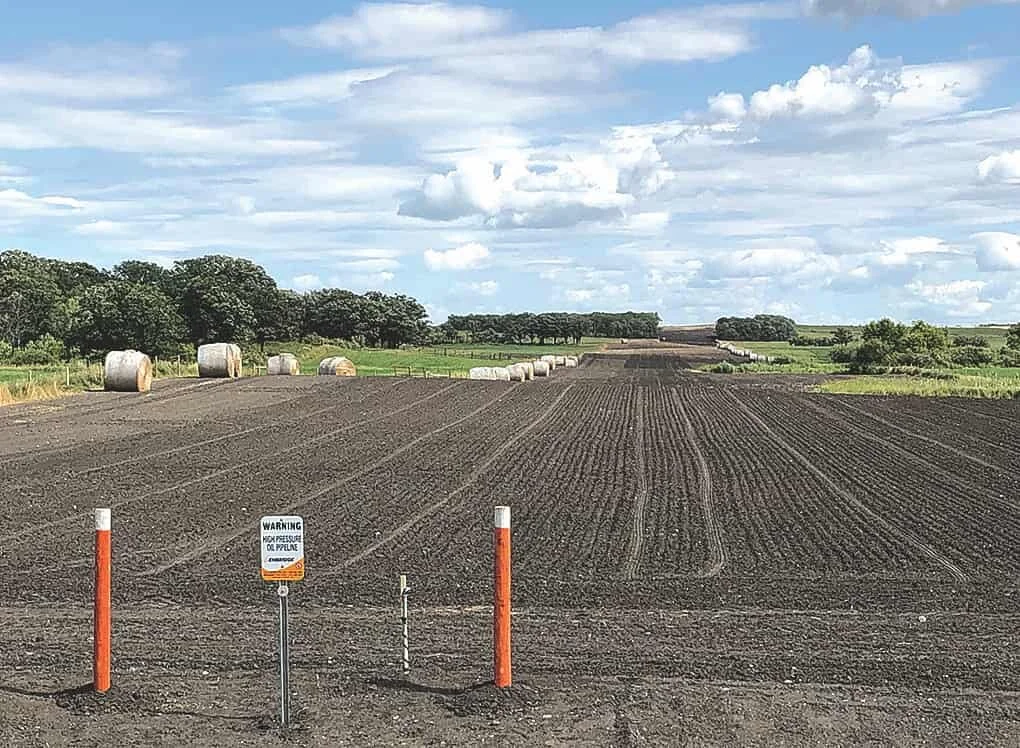Pipeline reclamation nears completion
In western Saskatchewan, small crews will be conducting ‘deficiency-warranty work’ along the Line 3 project right-of-way
Enbridge’s newly constructed Line 3 replacement pipeline (L3RP) runs for 1,070 kilometres in Canada, through parts of the three Prairie provinces from Hardisty, Alberta to the Manitoba-North Dakota border near Gretna. It crosses nearly 2,200 parcels – encompassing farm and pastureland, numerous creeks and wetlands, and larger water bodies like the South Saskatchewan and Souris rivers.
The Canadian portion of the new pipeline has been in service since December 2019 and most of the land along the project right-of-way (ROW) has already been returned to a pre-construction state.
From east-central Alberta to southeast of Regina around Vibank and Odessa, task-specific crews are conducting what Enbridge refers to as ‘deficiency-warranty work’ – repairing ditches, fences, gates and signs, re-seeding areas of slow growth and adding straw crimping for erosion control in areas where the previous covering had seen stress with a strong spring wind. General ‘housekeeping’ activity will continue in the region through the season.
“We are always monitoring the right-of-way, particularly during and after spring breakup,” explains Sawatzky. “If there’s an issue because of our activities, we’ll come out and make the repairs necessary. We have much respect for all landowners. We are guests on their land.”
This monitoring involves keeping an eye out for any new weed infestations along the ROW, in which case, with landowner approval, Enbridge will launch vegetation and weed management to control the spread of new weeds.
Meanwhile, in southeastern Saskatchewan and southwestern Manitoba (construction spreads 5, 6 and 7), final reclamation/topsoil replacement is well underway over a stretch of some 110 kilometres that could not be completed last year before the arrival of early wet and cold weather conditions. Most reclamation occurs within the first year following construction. However, it can take longer, depending on weather and other environmental conditions.
Banister Pipelines is overseeing a crew of about 280 workers for the final reclamation, which began in mid-June and includes grading, replacing topsoil and final cleanup, out of a main base in the town of Moosomin and a satellite office in Brandon.
“Our promise is to restore the pipeline right-of-way to as good or better condition than it was before construction, and to minimize the long-term impact to the land along our pipelines,” says Allen Sawatzky, Manager of Construction for the L3RP. “We continue to do what we said we would do.”
A critical component of right-of-way reclamation involves working with landowners, from the outset of a project, to reach agreement on property-specific items that will be addressed during and after construction.
During excavation for the Line 3 replacement pipeline, topsoil was separated from the subsoil to ensure the land remains productive for agricultural purposes after construction. The land was re-contoured to maintain drainage patterns, hay land and native prairie areas reseeded, cultivated land prepared for planting, and wetlands and watercourses stabilized and revegetated to prevent erosion and ensure habitat is restored for the many plants and wildlife along the line.
“Segregating topsoil during construction enhances restoration by returning the nutrients and seed back to the ground surface after construction,” says Sawatzky. “We also straw crimp, seed, and monitor the right-of-way until vegetation is re-established. In some cases, we also work with landowners and environmental agencies to enhance restoration, such as planting trees along streams or managing invasive species.”
Although most temporary workspaces will be allowed to grow back, Enbridge generally maintains the permanent right-of-way free of structures, trees and shrubs so the pipeline is visible during aerial inspections and accessible in the case of an emergency.
As of mid-July, both the warranty work and final reclamation were proceeding smoothly, thanks to cooperation from Mother Nature. Weather permitting, the work is expected to be completed in the fall.
“We’re above ground now with the remaining works, not below,” says Sawatzky. “The pipe install work has been completed; there are very few issues now until completion – only weather,” says Sawatzky.
“The weather affects us just like it does for farmers,” he adds. “As I like to say: ‘If you can’t combine, you probably can’t pipeline.’”
WORKING SAFELY DURING THE COVID-19 PANDEMIC
During the COVID-19 pandemic, both federal and provincial governments have recognized energy infrastructure and agriculture as essential services. The final L3RP reclamation work will ensure the return of farmland to productive use as soon as possible.
To execute the reclamation work safely and efficiently, Enbridge is following a robust COVID-19 Pandemic Protocol which sets common expectations and new ways of working and includes a digital worksite inspection tool that supports proper social distancing, deep cleaning, hand hygiene, site-access health assessments and other key activities.
“We’re operating across North America at a heightened level of emergency response preparedness and staying closely connected to recommendations from public health authorities and medical experts,” explains Sawatzky. “We know that COVID-19 has had a deep impact in the communities where we operate and we’re committed to ensuring the health and safety of our contractors and employees, as well as the communities near our projects.”
PHOTO #1 Groomed ROW is ready for straw to be laid down.
PHOTO #2 A fully reclaimed portion of the ROW with canola crop.
PHOTO #3 Crimped straw is spread to prevent wind erosion.



